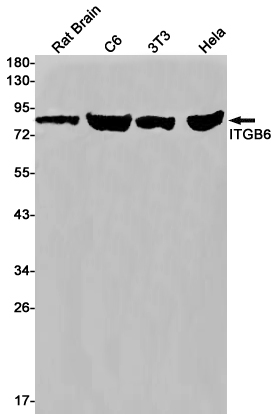
| WB | 1/500-1/1000 | Human,Mouse,Rat |
| IF | 1/20 | Human,Mouse,Rat |
| IHC | 咨询技术 | Human,Mouse,Rat |
| ICC | 技术咨询 | Human,Mouse,Rat |
| FCM | 咨询技术 | Human,Mouse,Rat |
| Elisa | 咨询技术 | Human,Mouse,Rat |
| Aliases | AI1H; Integrin beta-6 |
| Entrez GeneID | 3694 |
| WB Predicted band size | Calculated MW: 86 kDa; Observed MW: 86 kDa |
| Host/Isotype | Rabbit IgG |
| Antibody Type | Primary antibody |
| Storage | Store at 4°C short term. Aliquot and store at -20°C long term. Avoid freeze/thaw cycles. |
| Species Reactivity | Human,Mouse,Rat |
| Immunogen | A synthetic peptide of human ITGB6 |
| Formulation | Purified antibody in TBS with 0.05% sodium azide,0.05%BSA and 50% glycerol. |
+ +
以下是关于Integrin beta 6抗体的3篇参考文献示例:
---
1. **标题**: *"Blocking integrin αvβ6 reduces fibrosis in a murine model of pulmonary fibrosis"*
**作者**: Sheppard D, et al.
**摘要**: 该研究通过使用特异性抗Integrin β6的抗体,在小鼠肺纤维化模型中抑制了TGF-β的激活,显著减少了胶原沉积和纤维化标志物表达,表明靶向β6可能成为治疗纤维化疾病的潜在策略。
---
2. **标题**: *"Integrin αvβ6 promotes tumor progression in colorectal cancer by modulating the tumor microenvironment"*
**作者**: Munger JS, et al.
**摘要**: 作者发现Integrin β6在结直肠癌细胞中高表达,并通过抗体阻断实验证明其通过激活基质金属蛋白酶(MMPs)促进肿瘤侵袭和转移。抗β6抗体可抑制肿瘤微环境中的基质重塑。
---
3. **标题**: *"Targeting αvβ6 integrin with a humanized antibody for the treatment of chronic pancreatitis"*
**作者**: Goodman SL, et al.
**摘要**: 研究开发了一种人源化抗Integrin β6抗体,并在慢性胰腺炎模型中验证其疗效。结果显示,该抗体通过抑制炎症细胞浸润和纤维化通路,显著缓解了胰腺组织损伤。
---
这些文献涵盖了Integrin β6抗体在纤维化、肿瘤及炎症性疾病中的机制研究和治疗应用。如需具体文献,建议通过PubMed或Sci-Hub输入关键词(如“Integrin beta 6 antibody”、“αvβ6 therapeutic”)进一步检索。
Integrin beta 6 (ITGB6) is a subunit of the αvβ6 heterodimeric transmembrane receptor, part of the integrin family that mediates cell-cell and cell-extracellular matrix interactions. Primarily expressed on epithelial cells, ITGB6 binds to arginine-glycine-aspartic acid (RGD) motifs in ligands like fibronectin, tenascin, and latent TGF-β complexes. Its interaction with TGF-β is critical, as ITGB6 activates latent TGF-β1 and TGF-β3. regulating processes such as tissue repair, immune response, and fibrosis.
Under normal conditions, ITGB6 expression is low but increases during injury, inflammation, or malignancy. It plays dual roles: promoting wound healing in acute settings but contributing to pathological fibrosis (e.g., lung, liver) and cancer progression in chronic diseases. In cancers (e.g., pancreatic, breast), elevated ITGB6 correlates with metastasis, epithelial-mesenchymal transition (EMT), and poor prognosis.
ITGB6-targeting antibodies are valuable tools for research and therapeutics. They block TGF-β activation or ligand binding, offering potential in treating fibrosis or cancers. Diagnostic applications include detecting ITGB6 overexpression as a biomarker in pathological tissues. However, challenges remain in balancing therapeutic efficacy with off-target effects due to TGF-β's pleiotropic roles. Current studies focus on antibody-drug conjugates or combination therapies to enhance specificity and clinical outcomes.
×